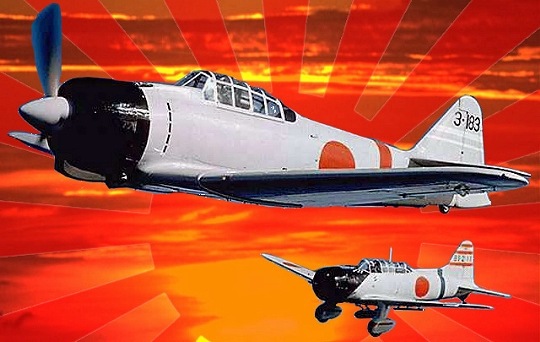It is not surprising, then, that Japanese aviators scored victory after stunning victory during the first six months of the war, from the attack on Pearl Harbor, through the sinking of the British men of war Prince of Wales and Repulse, to the fearsome raids on Northern Australia and IJN's* rampage throughout the Indian Ocean in April 1942.
 |
| Source: combined fleet.com |
However, at the end of World War I, as other countries scaled back their military spending, the Japanese increased production of their planes in the 1920s. Around this time the Navy constructed its first aircraft carriers; the United States had their own as well. Japanese Naval leader Isoroku Yamamoto felt the need to have "long range bombers that could strike Yankee warships."
The following are featured Mitsubishi World War II era Aircraft:
- Nell (1936)- Struck Chinese targets 1,250 miles away in the Second Sino-Japanese War
- Betty (1939)- Could fly over 2,00 miles without refueling;
- Zero (1939)- Extremely lightweight and nimble. Over 10,000 were built.
Here are the specifications on the Mitsubishi Zero:
- 332 MPH
- range of 1,930 miles
- 29 feet and nine inches long
- wingspan of 39 feet
The Zero had a crew of one, and was armed with machine guns and bombs. It utilized lightweight aluminum for its maneuverability. Unfortunately, this top secret aluminum lacked armor to protect the pilots, and did not have self-sealing fuel tanks. Allied pilots later learned to exploit this weakness by double teaming Zero planes in dogfights or striking during the "dive" or "climb".
Moreover, many of the military decisions of World War II came from the leader of Japan, General Hideki Tojo. Tojo was the Prime Minister of Japan from (October 1941- July 1944). He was an aggressive Army General who became Minister of War in July 1941 and Prime Minister in October 1941.
According to howstuffworks.com, the delicate manners of Japanese diplomats dispatched to Washington during the period before the Pearl Harbor attack were indeed very deceptive. There was also a perception that the Mitsubishi aircraft were a poor imitation of Western aviation. The Japanese military prior to Pearl Harbor was not considered a formidable opponent. Yet all those assumptions quickly changed the morning of December 7, 1941. The Allies had no aircraft match until 1943.
And when I asked my Dad about enemy planes in the Pacific, some seventy years later, he just didn't say planes, but automatically included the name "Mitsubishi."
 |
| Source: www.historynavymil.com |
*IJN: Imperial Japanese Navy
http://militaryhistory.about.com/od/militaryaircraft/p/a6mzero.htm

No comments:
Post a Comment